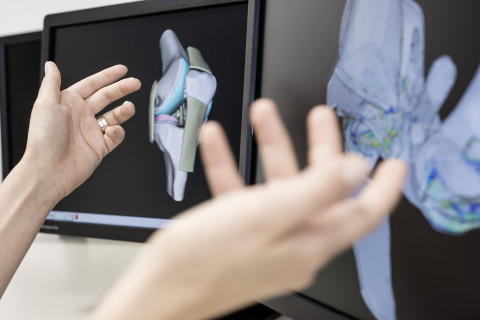Arthroscopic NIRS is based on statistical multivariate modeling of the interactions between connective tissues and near infrared (NIR) light. As deterioration of the tissue changes its optical absorption and scattering properties, NIRS can rapidly and non-destructively estimate the integrity and overall health of the tissue. Compared to the traditional arthroscopic evaluation, NIRS is a less subjective, more repeatable, and most importantly, it is a quantitative technique. While arthroscopic NIRS has been proven to be suitable for investigating articular cartilage, meniscus, and subchondral bone, its capabilities in evaluating properties of knee ligaments have largely been ignored.
Knee ligaments are collagenous viscoelastic bands of connective tissue that restrain and support the knee joint under natural loading conditions. Together with the other connective tissues of the knee, they ensure the correct mechanical function of the joint. Ligament injuries, such as anterior cruciate ligament rupture, are rather common and often occur simultaneously with other joint injuries as a result of sudden trauma, such as a traffic or sporting accident. An NIRS-based evaluation could provide additional diagnostic information regarding the ligament's condition during any arthroscopically performed repair procedure of the knee, as has previously been demonstrated for articular cartilage and meniscus. The similarities in composition and structure between ligaments, cartilage, and meniscus suggest that NIRS could be sensitive in evaluating the ligament's mechanical function, chemical composition, and internal structure. The first aim of this thesis was to thoroughly investigate which of these properties of knee ligaments and the patellar tendon could be quantitatively evaluated using NIRS.
The accuracy of the multivariate models describing the relationship between the NIR spectra and tissue properties is highly dependent on the quality of the NIRS measurement. Instrumentation noise, saturation, and scattering effects present in the spectra can substantially distort and lower the accuracy of the models. Various preprocessing operations can be sequentially combined into pipelines in order to reduce or eliminate noise contaminants from the spectra. The selection of the best possible pipeline for a given application is not, however, straightforward and needs to be optimized on a case-by-case basis. Therefore, the secondary aim of this thesis was to provide a more systematic and automated way of generating preprocessing pipelines for multivariate NIRS models by developing an open-source NIRS preprocessing module utilizing Python. The module was tested and validated using a set of arthroscopic NIRS measurements from fully characterized equine fetlock joints collected as a part of an earlier study. This dataset was also documented and published as a part of the thesis to further ameliorate the method development in the field of chemometrics.
Studies I and II utilized knee ligament and patellar tendon samples from ten bovine stifle joints and subjected them to NIRS measurements as well as undertaking a comprehensive characterization of the joints' mechanical, chemical, and structural properties. The suitability of NIRS for predicting different properties of the tissue was investigated with multivariate modeling techniques. The results of study I indicated that mechanical properties related to yield and failure mechanics of the tissue could be predicted with the highest accuracy. This finding was supported by study II which reported that the collagen and water contents seemed to be the compositional properties with the highest prediction accuracy. However, no evidence was found that NIRS would be sensitive towards the internal structure or morphology of ligament samples. In study III, an open source tool was developed for automatically combining spectral preprocessing operations into preprocessing pipelines. Its applicability to real world problems was demonstrated with two public datasets. In both examples, the automated preprocessing managed to improve the accuracy of the baseline (i.e., no preprocessing) models and provided objective means of producing the preprocessing pipeline. Study IV curated, documented, and published an open dataset of arthroscopic NIRS measurements and the associated reference variables. The dataset of study IV was used to test the preprocessing tool developed in study III and it may in the future be used in a similar fashion for the development or benchmarking of new methods.
In conclusion, NIRS was found to be sensitive towards certain mechanical and compositional properties of knee ligaments and the patellar tendon. Since these properties are related to the overall mechanical strength of the tissue, NIRS could potentially be a useful diagnostic tool for the quantitative evaluation of ligament tissue integrity during arthroscopic evaluation of the joint. Therefore, arthroscopic NIRS could be suitable for obtaining a quantified analysis of all connective tissues found within the knee and other synovial joints. The automated preprocessing optimization improved the prediction accuracy of multivariate models in the two examples evaluated. The open source spectral preprocessing tool developed as a part of this thesis should enable future NIRS investigators to adopt a more systematic, objective, and reproducible approach for optimizing preprocessing pipelines.
The doctoral dissertation of MSc (Tech.) Jari Torniainen, entitled Near Infrared Spectroscopy-Based Evaluation of Patellar Tendon and Knee Ligaments will be examined at the Faculty of Science and Forestry on the 30th of October in Kuopio. The opponent in the public examination will be professor Jürgen Popp, Leibniz Institute of Photonics Technology, Germany, and the custos will be dosent Lauri Stenroth, University of Eastern Finland. The public examination will be held in English.
Photo of Jari Torniainen available for download at https://mediabank.uef.fi/A/UEF+Media+Bank/38120?encoding=UTF-8.
